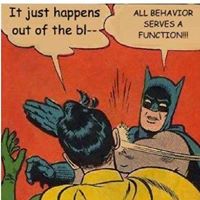Trainings
are something I do regularly as part of my job as a BCBA…..for this month alone
I have 3 on my calendar.
Occasionally I’m given the awesome opportunity
to do a training or presentation to a target audience of laypersons: people who
know little to nothing about ABA or Autism. I love opportunities like this. It’s exciting to speak to people who
know NOTHING about ABA and to get to be the one to introduce them to it.
I do think
there is a distinct way to convey information to an audience of “ABA Geeks” vs.
an audience of laypersons. Part of having a passion for this field includes
spreading the word about what ABA can do to help people. ALL kinds of people.
If I present ABA in a way that seems too intimidating, overly limited, mundane
or boring, etc., then I’m doing a disservice to the field.
It’s an interesting
challenge to present a massive topic like ABA to a variety of audiences, in a
way they can grasp. The ability to modify your own teaching/training style is
highly valuable, and not everyone can do that.
I remember
going to a local Autism conference several years ago, and attending a workshop
on problem behaviors held by a very esteemed and experienced BCBA. The room was
packed, and people were even standing in the door to attend the workshop. The
BCBA took the first 40-45 minutes of a 60 minute presentation to provide a
super detailed explanation of types of assessment conditions, experimental
designs, topographies of problem behaviors, analyzing and displaying data….to a
packed room of teachers and parents. There was no time for anyone to ask
questions, and there was nothing concrete given to the audience that they could
immediately begin implementing with their kids/students. I learned a lot from
that experience. Knowledge is great, but
wisdom is the ability to filter knowledge appropriately depending on who you
are speaking to.
So in order
to help my fellow colleagues out there who may find yourself in the position of
conducting a training or presenting a topic to non-ABA professionals, I hope
these tips I have learned along the way are helpful to you.
Or, to let Einstein
say it better:
Training
Tips:
- Limit or just skip
the jargon – That’s
great that you can toss out ABA vocabulary like Establishing Effects, Functional Analysis, Stimulus Control, and Multielement Designs. However, if
you communicate at a level that goes over the head of your audience that
is very off-putting. A great ABA professional is bilingual: you know how
to speak with your colleagues, and how to translate that speech for a
general audience.
- Visual cues aren’t
just for our clients
– Include lots of video clips, photos, and actual content (like
a token board) in the training to help people grasp what you are describing.
Many ABA strategies can seem so technical and clunky, but if you are able
to show a video clip of the technique being successfully implemented that
can help people get that Lightbulb Moment of understanding.
- Get that “Buy In”- ABA at its core is just great
parenting or great teaching. That’s what your layperson audience needs to
hear. ABA is something most of my clients were doing in some capacity
before I ever met them; they just didn’t know it. Most parents naturally
prompt, reinforce, and use transition cues. I have had people attend my
trainings with the expectation of learning some new, space age method to
behavior management. Once I start talking, I often get reactions like “Oh, I already
do that!”. Yes, I know! That’s the point: help your audience buy in to
what you are saying by connecting it to what they are already doing right.
- Stay open minded:
Allow comments or questions
– Did I say allow?? I really meant “demand”. I constantly check to see if
the audience has questions during a training or presentation. If someone
is looking at me quizzically, I may tell him to ask me the question that his face indicates he has! I get some of the most interesting and unique
questions from laypersons, and it also widens my perspective about
behavior, learning, and being a caregiver to disabled children. Don’t
be afraid to open the floor for questions, critiques, or differing points
of view. It will keep you from having a closed off mind. If you only ever talk to people who
love ABA then how can you gain an understanding of why people hate ABA,
and what made them come to that decision?
- Talk about your
successes AND your failures – I share a lot of anecdotes or stories during my
trainings (I’m big on giving examples) and while it’s helpful to tell the audience
about the successes, what about the times when my strategy did NOT work? People don’t just want to hear about how ABA always works. They
also want to hear about what to do when your strategies are NOT working, when the problem
behaviors are not decreasing, and when you have zero buy in from the client’s
family. Don’t be afraid to discuss your failures or mistakes as a
professional. It may help someone else avoid your pitfalls.











